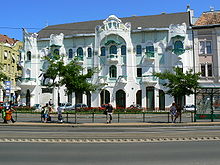


In contrast to Historicism, Hungarian Art Nouveau is based on supposed national architectural characteristics. Ödön Lechner (1845–1914), the most important figure in Hungarian Art Nouveau, was initially inspired by Indian and Syrian architecture, and later by traditional Hungarian decorative designs. In this way, he created an original synthesis of architectural styles. Turning away from the style of Lechner, yet taking inspiration from his approach, the group of 'Young People' (Fiatalok), which included Károly Kós and Dezső Zrumeczky, applied the characteristic structures and forms of traditional Hungarian architecture, especially the Transylvanian vernacular, to achieve the same end. Besides the two principal styles, Hungarian archiecture also displays local versions of trends originating from other European countries. The Sezession from Vienna, the German Jugendstil, Art Nouveau from Belgium and France, and the influence of English and Finnish architecture are all reflected in the buildings constructed at the turn of the 20th century. Béla Lajta initially adopted Lechner's style, subsequently drawing his inspiration from English and Finnish trends; after developing an interest in the Egyptian style, he finally arrived at modern architecture. Aladár Árkay took almost the same route. István Medgyaszay developed his own style, which differed from Lechner's, using stylised traditional motifs to create decorative designs in concrete. In the sphere of applied arts, those chiefly responsible for promoting the spread of Art Nouveau were the School and Museum of Decorative Arts, which opened in 1896

No comments:
Post a Comment